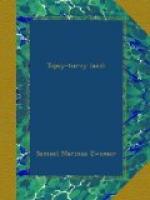The Bedouin are divided into many tribes and clans. Some of them are friendly to each other but nearly all are at war with one another all the year round. Robbery and murder are very frequent. Every one goes armed with a long spear or with a gun, and many carry a war club and a sword as well. The largest Arab tribes and the wealthiest are the Anaeze and the Shommar. They have many fine horses. In the picture you see a group of them armed with their long spears. The spear of the leader is ornamented with a tuft of ostrich feathers; these spears are often over twelve feet long and have a sharp steel lance at the end. The Arabs are fond of games, especially galloping their horses and playing at war. They are very skillful riders and kind to their steeds; they do not spend much time in grooming them and they never use a whip and seldom a bit. Their bridle is like our halter strap, and the horse is so well trained that he needs no iron bit in his mouth.
One of the most interesting of all the Arab tribes is called the Suleibi. They are despised by all the other Arabs and seem to be of a different race. The women of this tribe are remarkable for their beauty and the men for their skill as blacksmiths and tinkers. They are always sought after to do the tinkering for the Arabs of all other tribes. They have no camels or horses but ride little donkeys and dress in gazelle skins. Some people think that this tribe is a remnant of the Christian population of Arabia; they have many curious beliefs and their name means, “Those-of-the-Cross.” Perhaps some day a missionary will bring them back to a true knowledge of the Crucified One.
The nomads of Arabia are happy in springtime when there is enough grass for their flocks and the wells of the desert are full of water. But after the long summer drought there is often a great scarcity of food and even famine in many parts of Arabia. Then the nomads eat anything and drink the brackish water from the bottom of a mud pool with relish. In no country in the world is water so costly as in Arabia; nowhere is it so carefully used; an Arab never wastes a drop of water and looks surprised and pained when an European traveller rinses out a cup before drinking! The nomad Arabs eat locusts and wild honey as did John the Baptist. But I have also seen them eat the big lizards of the desert and the jerboas—a sort of desert rat. An Arab once stood amidst a circle of jewellers at Busrah and said: “On one occasion I had missed my way in the desert, and having no road-provision left, I had given myself up for lost, when all at once I found a bag of pearls. Never shall I forget that relish and delight so long as I mistook them for parched wheat; nor that bitterness and disappointment when I discovered that they were real pearls!” This story is told by a Persian poet and although it may not be true yet it teaches a lesson. To a hungry man a handful of wheat is better than all the pearls of the ocean.




